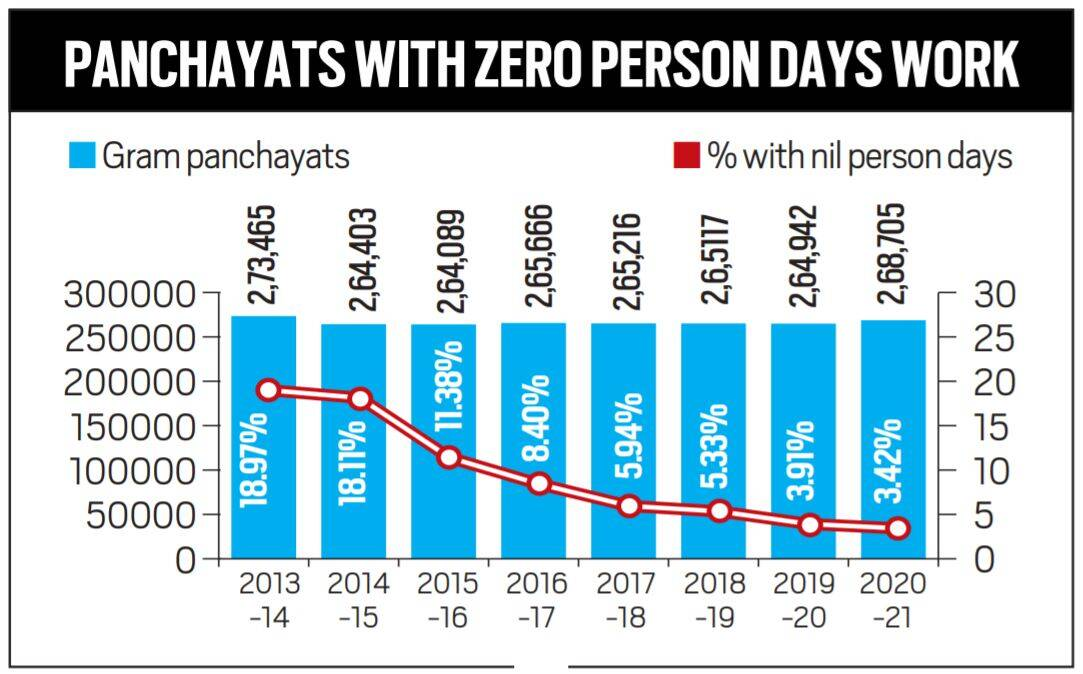Social Justice
Rise in NREGS Demand
- 01 Dec 2020
- 4 min read
Why in News
A recent analysis of data available up to November on the National Rural Employment Guarantee Scheme (NREGS) portal shows that demand for work has been at all time high.
Key Points
- The NREGS is a demand-based scheme and has emerged as a safety net during the pandemic for jobless migrant workers returning to their villages
- Despite a progressive relaxation in Covid-19 curbs to revive the economy, 96% gram panchayats have logged work under the scheme in the financial year (2020-21) as compared to previous seven years.
- The number of gram panchayats generating nil person days of work (panchayats with zero person days work) during the current financial year are at an eight-year low of only 3.42% of the 2.68 lakh gram panchayats across the country.
- In 2019, the number of gram panchayats generating nil person days during the entire period was 3.91% of the total 2.64 lakh gram panchayats.
- Over 96% of gram panchayats across the country have registered demand for work under NREGS from April till November-end.
- Over 6.5 crore households, covering 9.42 crore individuals, have availed NREGS till November 2020, which is an all-time high.
- Over 265.81 crore person days have been generated, which is higher than 265.44 crore generated in 2019.
- 1.98 crore households availed the scheme in October 2020, which is 82% higher than 2019.
- Highest number of demand for work came from Tamil Nadu, West Bengal, Uttar Pradesh and Madhya Pradesh.
- The wage expenditure has also reached an all-time high of Rs. 53,522 crore during this period.
- Tamil Nadu has reported the highest figure of households that availed the NREGS across the country, since July and has been followed by West Bengal.
- These two states were not covered under the Garib Kalyan Rojgar Abhiyaan.
National Rural Employment Guarantee Scheme
- The Mahatma Gandhi National Rural Employment Guarantee Act, 2005 was notified by the Government of India on September, 2005 and was made effective in February 2006. Under it, the NREGS was introduced.
- The Act aims at enhancing the livelihood security of people in rural areas by guaranteeing hundred days of wage employment in a financial year to a rural household whose adult members (at least 18 years of age) volunteer to do unskilled work.
- The central government bears the full cost of unskilled labour, and 75% of the cost of material (the rest is borne by the states).
- It is a demand-driven, social security and labour law that aims to enforce the ‘right to work’.
- Ministry of Rural Development in association with state governments, monitors the implementation of the scheme.
Garib Kalyan Rojgar Abhiyaan
- It was launched in June 2020 to empower and provide livelihood opportunities to the returnee migrant workers and rural citizens who had returned to their home states due to the lockdowns.
- It worked in mission mode for 125 days with an outlay of Rs. 50,000 crore.
- A total of 116 districts across six states, namely Bihar, Uttar Pradesh, Madhya Pradesh, Rajasthan, Jharkhand and Odisha were chosen for the campaign.
- These districts covered the maximum number (about 2/3) of such migrant workers who had returned.
- The chosen districts include 27 Aspirational Districts, districts which are affected by poor socio-economic indicators. These are aspirational in the context, that improvement in these districts can lead to the overall improvement in human development in India. It is a NITI Aayog’s Programme.







